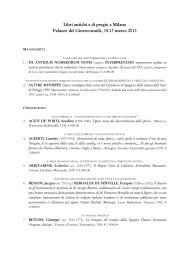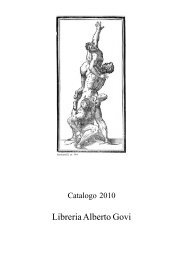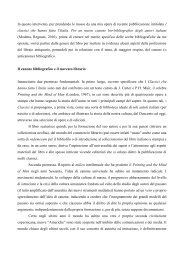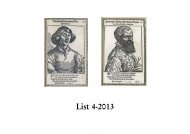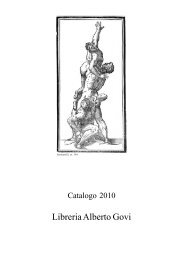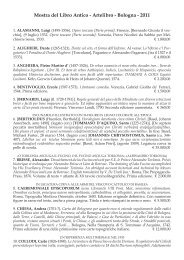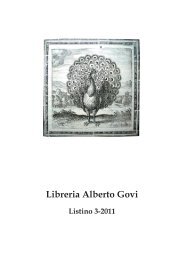manifesto to claim Pico’s and Pio’s own rights on theirpossessions, i.e. Mirandola and Carpi (cf. L. Balsamo,<strong>Alberto</strong> III Pio e Aldo Manuzio: editoria a Venezia e Carpifra ‘400 e ‘500, in: “Per la storia del libro. Scritti di LuigiBalsamo raccolti in occasione dell’80° compleanno”, Firenze,2006, pp. 68-71).Giovan Francesco Pico was born at Mirandolain 1469 from Galeotto I Pico, brother of Giovanni Picodella Mirandola, the famous philosopher. He receivedhis education at the court of Ferrara, but it was the uncleGiovanni, only six years older, who had a major influenceon him. In 1496 he published Giovanni’s OperaOmnia, adding a biography of the uncle at the beginningof the edition. Another influential figure in the educationof Giovan Francesco was Girolamo Savonarola, to whomhe dedicated his De morte Christi et propria cogitanda libritres. In 1499, after the death of his father Galeotto, GiovanFrancesco became Lord of Mirandola by imperial investiture.But soon after his younger brothers, Ludovicoand Federico, supported by their mother, began to claimtheir rights and, with the help of the condottiere Gian GiacomoTrivulzio, conquered Mirandola, forcing GiovanFrancesco into exile. In the following years he publishedthe treaty De Immaginatione, and tried to regain his possessionswith the support of <strong>Alberto</strong> Pio. He also went toGermany twice to claim his own possessions before theEmperor Maximilian.In the meanwhile, between 1506 and 1509, hismother and brothers died; Mirandola was then ruledby Galeotto under the regency of his mother, FrancescaTrivulzio, Ludovico’s widow. Only in 1511, by obtainingthe protection of the emperor and of pope Julius II, Giovan Francesco was again established as legitimate ruler ofMirandola. During the exile he published some important works, among them De Rerum praenotione, Theoremata defide, and De providentia Dei. However, in June 1511 Gian Giacomo Trivulzio, at the head of the French army, enteredMirandola and forced Giovan Francesco to escape. A solution to the problem of the possession of Mirandola wasfound only in 1514, when through imperial intercession an agreement was reached between Francesca Trivulzioand Giovan Francesco: this latter obtained Mirandola, while Francesca became the ruler of Concordia.Back to Mirandola, Giovan Francesco devoted himself to the studies. In 1516 he published in Rome the Deamore divino, in 1519 the De imitatione and the Physici libri duo. The De veris calamitatum causis nostrorum temporumwas issued in 1519 at a newly open printing press in Mirandola. In 1523 he published Strix sive de ludificatione daemonium,one of his most important treatises. Giovan Francesco had an intense correspondence with many scholars andhumanists all over Europe, like Johann Reuchlin, Pietro Bembo, Lilio Gregorio Giraldi, Jacopo Sadoleto, and manyothers. He was assassinated in 1553 by killers sent against him by his nephew Galeotto (cf. P. Castelli, Giovanni eGianfrancesco Pico: l’opera e la fortuna di due studenti ferraresi, Firenze, 1998, passim; and A. Traldi, Gianfrancesco Picodella Mirandola, il litteratissimo, Nonantola, 1994, passim).Edit 16, CNCE33866; Adams, P-1151. € 6.800,00one of Luther’s teachers in philosophy at Erfurt7) ARNOLDI DE USINGEN, Bartholomaeus (ca. 1465-1532). Parvulus philosophiae naturalis Figuralisinterpretatio in Epitoma philosophie naturalis in laudatissimo Erffurdiensi gymnasio per Barth. de Usingen liberaliumstudiorum concinnata… Annexa est huic opuscolo Quaestio ardua de Quiditate quantitatis continue.Basel, Jakob Wolff, December 4, 1511.4to; later half vellum; CXL [i.e. 130], (1 blank) ll. A 8 , B-C 6 , D4, E-G 8 , H 12-1 , I 6 , K-S 8 , T 4 . In gathering H the last leaf (H12)is not present as in all copies (cf. Adams, U-91). With a large woodcut on leaf XLVIIIv. In the final index the pagenumbering has been added by a contemporary hand. A nice copy.SECOND EDITION (first: Leipzig, 1499) of this compendium on natutal philosophy intended to introduce studentsinto the application of nominalistic criteria. The author of the text for which Arnoldi made his commentarywas apparently not known to him. He has been identified as Peter of Dresden (Peter Gerticz), whose treatise withthe same title, Parvulus philosophiae naturalis, was often used as teaching material in the city schools since theend of the fourteenth century. It was a concise exposition of the main contents of Aristotelian natural philosophy(cf. P. Kärkkäinen, Psychology and the Soul in Late Medieval Erfurt, in: “Vivarium”, 47, 2009, p. 425; see also S. Lalla,Secumdum viam modernam. Ontologischer Nominalismus bei Bartholomäus von Usingen, Würzburg, 2003, pp. 77-89).The work contains overall 56 Quaestiones, each one beginning with ‘Utrum’, divided into two groups. At- 8 -
the end is furthermore printed the text of a quodlibetdisputation which took place at Erfurt in 1497and in which the leading teachers of the philosophyfaculty, Jodocus Trutfetter and BartlolomaeusArnoldi, determined the position with respect tocertain questions in a programmatic manner, i.e.their explicit adherence to William Ockham’s philosophy.It is here printed under the title Questioannexa de Quiditate Quantitatis continue (cf. S.Lalla, op. cit., pp. 94-140).Bartholomaeus Arnoldi (also called Usingenafter his birthplace) began his studies at theUniversity of Erfurt in 1484. He became a bachelorof arts in 1486 and master of arts in 1491. Hetaught philosophy at Erfurt for twenty-four years.In 1498, he became a member of the council of thefaculty of arts and afterwards was active in severalofficial positions. From 1501 to 1505, he wasone of Luther’s teachers in philosophy. During1504 he was dean of the faculty and joined the Augustinianhermits in 1512. Two years later he waspromoted doctor of theology and became activelyinvolved in the German Counter Reformation andin particular opposed the Wittenberg reformers.In 1522, he became archdeacon. He was forcedto leave Erfurt during the Peasant’s War in 1525and ended up in Würzburg, where he stayed atthe local Augustinian monastery. During his lastyears, Arnoldi followed the local bishop, Konradvon Thüngen, in visitations to the monasteriesand even participated in the Diet of Augsburg in1530, where he was appointed as a member of the commission to examine the Augsburg Confession and where hecontributed to the writing of the Catholic Response. He died in Würzburg in 1532.As a philosopher Arnoldi belonged to the ‘via moderna’ school as did all his colleagues at the faculty ofarts in Erfurt. They were committed to respect certain authoritative writers and to adopt some key doctrines. Theseauthorities included, above all, Jean Buridan and William of Ockham, but also such authors as Gregory of Rimini,Peter of Ailly, and Gabriel Biel. These doctrines included, among others, the use of the principle of parsimony, amoderate nominalist view of universals, and the denial of a real distinction between the powers of the soul as wellas between the entities denoted by the Aristotelian categories other than substance and quality (cf. R. Bäumer, Bartholomäusvon Usingen OESA, in: “Katholische Theologen der Reformationszeit”, E. Iserloh, ed., Münster, 1985, II,pp. 27-37; and S. Lalla, op. cit., pp. 15-22).Index Aureliensis, 108.934; VD 16, P-813; Adams, U-91; E. Kleineidam, Universitas studii Erffordiensis. Überblick überdie Geschichte der Universität Erfurt im Mittelalter, 1392-1521, Leipzig, 1992, p. 301; S. Lalla, op. cit., p. 403; C.H. Lohr,Latin Aristotle Commentaries (II) Renaissance Authors, Florence, 1988, pp. 20-21. € 1.800,00second copy known8) CROTUS RUBEANUS, Johannes (1480-1545). Oratio hec est funebris. / In laudem IOANNIS CERDO-NIS / Qua[m] nominauimus VADEMECUM / Quia cum emeris tunc portas tecum / Cum duabus epistolis clarorumvirorum / Quas nequa[que] dices imperitorum. N.pr., n.pl., n.d. , [1518 ca.].Small 8vo (mm. 122x85); blind-ruled calf in the style of Renaissance bindings with gilt corner pieces, spine with 3raised bands; (8) ll. A-B 4 . Small woodcut at the top of the title-page showing a German ruler. Cut short, but a verygood copy.SECOND COPY known of this satirical funeral sermon addressed to one Johann Cerdo (‘Shoemaker’) in the styleof the Letters of Obscure Men (1515-1518). The apparently only other copy of this issue is recorded in the AustrianNational Library in Vienna. Two other printings of this pamphlet are known, one supposedly printed at Leipzigby Wolfgang Stöckel in 1518, the other at Mainz by Johann Schöffer in the same year (with a title woodcut showingCerdo’s funeral).The attribution to Crotus was already hypothesized in the nineteenth century and was definitely acceptedwith W. Brecht’s arguments in Die Verfasser der Epistolae Obscurorum Virorum, Straßburg, 1904, pp. 156-167 (seealso P. Merker, Der Verfasser des Eccius Dedolatus und anderer Reformationsdialoge, Halle, 1923, p. 208).It is remarkable that Crotus’ pamphlet was used by François Rabelais for the “Quaestio utilissima, utrumChimera in vacuo bombinans posit comedere secundas intentions?” (Pantagruel, book I, chapter VII) (W. Schwob,François Rabelais, Paris, 2008, pp. 12-15).- 9 -
- Page 1 and 2: Catalogue 2013Libreria Alberto Govi
- Page 3 and 4: Catalogue 2013Libreria Alberto Govi
- Page 5 and 6: an hitherto unknown philosophical m
- Page 7: ustica Lib. X., edited by Giorgio M
- Page 11 and 12: without typographical data, but pro
- Page 13 and 14: Letteratura Italiana”, CXL, 1963,
- Page 15 and 16: as secondary only.The present two e
- Page 17 and 18: position as secretary at the court
- Page 19 and 20: From 1528 he was rector of the newl
- Page 21 and 22: famous personage was in high favor
- Page 23 and 24: Luigi Alamanni and Antonio Brucioli
- Page 25 and 26: In Pincio’s biography of Bernardo
- Page 27 and 28: Tempio della Fama; e così ne trass
- Page 29 and 30: power, and yet to make it possible
- Page 31 and 32: lini, Andrea Alciati, Lilio Gregori
- Page 33 and 34: phy in particular, was presented as
- Page 35 and 36: quale quello che lui auspicava, e l
- Page 37 and 38: After the flight of the Medici from
- Page 39 and 40: to learn from their own experience
- Page 41 and 42: with some manuscript compositions p
- Page 43 and 44: death sentence issued against him o
- Page 45 and 46: the key work to Della Casa’s thou
- Page 47 and 48: important ones along with those of
- Page 49 and 50: a heavily annotated copy44) HORATIU
- Page 51 and 52: solitudine (1545), but undoubtedly
- Page 53 and 54: provide less description of patholo
- Page 55 and 56: the most up-to-date scientific ency
- Page 57 and 58: (pp. 4-10) written by the author hi
- Page 59 and 60:
successivi alla consapevolezza che
- Page 61 and 62:
night [February 22]. Rarely does a
- Page 63 and 64:
subjects, including Saint-Gelais’
- Page 65 and 66:
Catherine de’ Medici, succeeded o
- Page 67 and 68:
losofico ed allegorico delle Metamo
- Page 69 and 70:
The act concerning primogeniture is
- Page 71 and 72:
are not many in number but who are
- Page 73 and 74:
the Camilletta, his first work, Gut
- Page 75 and 76:
selig, sich nit allein zu kunst geg
- Page 77 and 78:
dle, or low. There are, however, pr
- Page 79 and 80:
nity: ‘mercenaries should be done
- Page 81 and 82:
colò Sfondrati), to whom the Causa
- Page 83 and 84:
close of Semiramis’ career. Ninus
- Page 85 and 86:
e contenuti matematici in Henri de
- Page 87 and 88:
The first Hungarian dictionary - Cr
- Page 89 and 90:
& T. Kovács, Deutschlernen in den
- Page 91 and 92:
chitectura’ des Wenzel Dietterlin
- Page 93 and 94:
neo-Latin anthology devoted exclusi
- Page 95 and 96:
as De la puissance ecclésiastique
- Page 97 and 98:
colazione was not eaten first thing
- Page 99 and 100:
advanced both the technical and the
- Page 101 and 102:
di Giorgio Zorzi, ambasciatore in O
- Page 103 and 104:
the Misnah100) MISNAYOT MESUDAR NAS
- Page 105 and 106:
the task of taking part to the nego
- Page 107 and 108:
This is the only iconological work
- Page 109 and 110:
on that occasion, were described an
- Page 111 and 112:
millo Camilliani, Francesco’s son
- Page 113 and 114:
Blanchard, Correggio and Mignard, R
- Page 115 and 116:
di Cicerone d’ottime antiche stam
- Page 117 and 118:
Pietro Aretino125) MAZZUCHELLI, Gio
- Page 119 and 120:
music129) TESTORI, Carlo Giovanni (
- Page 121 and 122:
Vol. VIII (1773): pp. (6), 854 with
- Page 123 and 124:
Di Felice e Gregorio Fontana, 1905,
- Page 125 and 126:
Cicognara, no. 190 (“Nelle quattr
- Page 127 and 128:
mo: fonti, theorie, modelli, 1750-1
- Page 129 and 130:
commentary on the treaty on shabbat
- Page 131 and 132:
poet laureate of Austria, and he le
- Page 133 and 134:
geo-political situation of the regi
- Page 135 and 136:
ope collecting views and pictures o
- Page 137 and 138:
inc.), 100 numbered engraved plates
- Page 139 and 140:
a gift from Emperor Napoléon III t
- Page 141 and 142:
Ardène, no. 123Caprara, no. 103 Tr
- Page 143 and 144:
Speckle, no. 73 Besson, no. 60- 143



